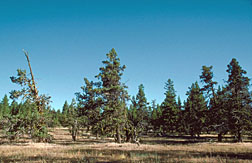This page has been archived and is being provided for reference purposes only. The page is no longer being updated, and therefore, links on the page may be invalid.
|
|
|
|
Burning Invasive Juniper Trees Boosts Perennial Grass Recovery
By Ann PerryAugust 27, 2010
Controlling juniper trees by cutting them down and burning them where they fall keeps invasive cheatgrass at bay and allows native perennials to become re-established, according to findings by U.S. Department of Agriculture (USDA) scientists.
Agricultural Research Service (ARS) rangeland scientists Jon Bates and Tony Svejcar conducted a study at a site dominated by a stand of invasive western junipers to assess different management strategies after the junipers have been cut down. ARS is USDA's principal intramural scientific research agency.
In the past century, junipers have begun to dominate some sagebrush grasslands in the western United States. Rangeland managers sometimes just cut down the invasive trees and leave them where they fall, which can help protect the soil from erosion. But the dead trees are an increased fire risk and may also create conditions that help cheatgrass—an invasive annual that fuels fierce wildfires—crowd out native perennials.
Bates and Svejcar, who work at the Eastern Oregon Agricultural Research Center in Burns, Ore., cut down a group of junipers and then burned them during the winter one and two years after they were felled. A control group of felled trees at the site was left unburned.
Ten years after the trees were burned, total herbaceous and perennial grass cover was 1.5 to 2 times greater in the areas where trees had been burned than in the areas where they were not burned. Perennial grass density was 60 percent greater in the burned sites than in the unburned sites, and cheatgrass cover was twice as dense in the control area than in the two burn areas.
The researchers concluded that burning the cut trees in winter helped protect existing perennials at the site because the soils were wet and frozen. This protection gave the perennials a head start in their growth the following spring, when they needed an edge against invasive annuals.
Results from this work, which support the USDA priority of responding to climate change, were published in Western North American Naturalist.

